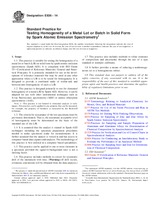Potrebujeme váš súhlas na využitie jednotlivých dát, aby sa vám okrem iného mohli ukazovať informácie týkajúce sa vašich záujmov. Súhlas udelíte kliknutím na tlačidlo „OK“.
ASTM E826-14
Standard Practice for Testing Homogeneity of a Metal Lot or Batch in Solid Form by Spark Atomic Emission Spectrometry (Withdrawn 2023)
Automaticky preložený názov:
Štandardný postup skúšania homogenity Metal šarže alebo zásielky v pevnej forme, o Spark atómovú emisnú spektrometriou
NORMA vydaná dňa 1.4.2014
Informácie o norme:
Označenie normy: ASTM E826-14
Poznámka: NEPLATNÁ
Dátum vydania normy: 1.4.2014
Kód tovaru: NS-48138
Počet strán: 28
Približná hmotnosť: 84 g (0.19 libier)
Krajina: Americká technická norma
Kategória: Technické normy ASTM
Kategórie - podobné normy:
Anotácia textu normy ASTM E826-14 :
Keywords:
atomic emission spectroscopy, homogeneity, reference materials, ICS Number Code 77.040.99 (Other methods of testing metals)
Doplňujúce informácie
| Significance and Use | ||||||||||||||||||
|
5.1 The purpose of this practice is to evaluate the homogeneity of a lot of material selected as a candidate for development as a reference material or certified reference material, or for a L/B selected for some other purpose (see 5.2 This practice is applicable to the testing of samples taken at various stages during production. For example, continuous cast materials, ingots, rolled bars, wire, etc., could be sampled at various stages during the production process and tested. |
||||||||||||||||||
| 1. Scope | ||||||||||||||||||
|
1.1 This practice is suitable for testing the homogeneity of a metal lot or batch (L/B) in solid form by spark atomic emission spectrometry (Spark-AES). It is compliant with ISO Guide 35—Certification of Reference Materials: General and Statistical Principles. It is primarily intended for use in the development of reference materials but may be used in any other application where a L/B is to be tested for homogeneity. It is designed to provide a combined study of within-unit and between-unit homogeneity of such a L/B. 1.2 This practice is designed primarily to test for elemental homogeneity of a metal L/B by Spark-AES. However, it can be adapted for use with other instrumental techniques such as X-ray fluorescence spectrometry (XRF) or atomic absorption spectrometry (AAS). 1.3 The criteria for acceptance of
the test specimens must be previously determined. That is, the
maximum acceptable level of heterogeneity must be determined on the
basis of the intended use of the L/B.
1.4 It is assumed that the analyst is trained in Spark-AES techniques including the specimen preparation procedures needed to make specimens ready for measurements. It is further assumed that the analyst is versed in and has access to computer-based data capture and analysis. The methodology of this practice is best utilized in a computer based spreadsheet. 1.5 This practice can be applied to one or more elements in a specimen provided the signal-to-background ratio is not a limiting factor. 1.6 This practice includes methods to correct for systematic drift of the instrument with time. (1.7 This practice also includes methods to refine estimates of composition and uncertainty through the use of a type standard or multiple calibrants. 1.8 It further provides a means of reducing a nonhomogeneous set to a homogeneous subset. 1.9 This standard does not purport to address all of the safety concerns, if any, associated with its use. It is the responsibility of the user of this standard to establish appropriate safety and health practices and determine the applicability of regulatory limitations prior to use. |
||||||||||||||||||
| 2. Referenced Documents | ||||||||||||||||||
|
Podobné normy:
Historická
1.4.2009
Historická
1.10.2011
Historická
1.11.2013
Historická
1.6.2012
Historická
15.6.2008
Historická
15.6.2008
Odporúčame:
Aktualizácia zákonov
Chcete mať istotu o platnosti využívaných predpisov?
Ponúkame Vám riešenie, aby ste mohli používať stále platné (aktuálne) legislatívne predpisy
Chcete vedieť viac informácií ? Pozrite sa na túto stránku.



 ASTM E712-80(2009)..
ASTM E712-80(2009).. ASTM E81-96(2011)..
ASTM E81-96(2011).. ASTM E96/E96M-13..
ASTM E96/E96M-13.. ASTM F1459-06(2012)..
ASTM F1459-06(2012).. ASTM F1593-08
ASTM F1593-08 ASTM F1710-08
ASTM F1710-08
 Cookies
Cookies
